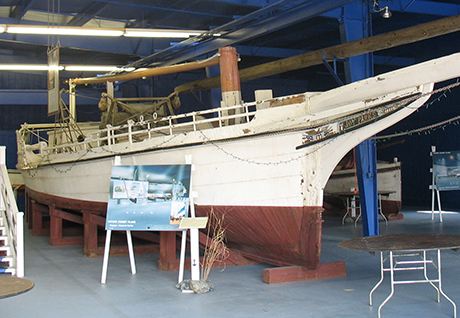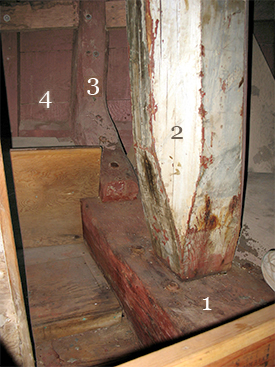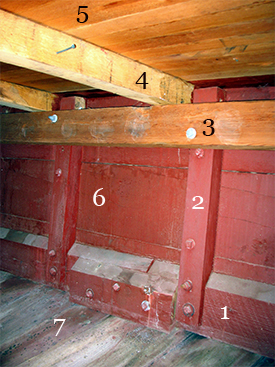For my master’s thesis at Flinders University in Australia I conducted research and survey work on the Chesapeake Bay Skipjack Joy Parks located at the Piney Point Lighthouse Museum in Piney Point Maryland. The goals of the research were to produce line, outboard profile, and deck plan drawings and to deduce how her builder, William T. Young, influenced other skipjack builders through the design of Joy Parks. These three profile drawings were chosen as they are the ones used by Howard Chapelle in Notes on Chesapeake Bay Skipjacks. As such, they will add to the body of knowledge on skipjacks which includes Mr. Chapelle’s collection.

The Joy Parks on display at the Piney Point Lighthouse Museum. Watch Video
Fieldwork consisted of one day to plan my approach followed by five days of survey. I set up a baseline to the port side of the vessel to take boat lines followed by the recording of baseline offset measurements. The side profile was completed by measuring the height above the ground as well as the baseline location for all rails and hull features. Measuring the height above the deck and their baseline location determined deck superstructures and boom features. Finally, the deck plan was made by measuring the length and width of deck features and locating them along the baseline. We strung three strings athwartship at known locations along the baseline and all measurements on the deck were made to these known locations. This technique greatly increased productivity without jeopardizing accuracy as compared to dropping lines off the side of the boat to the ground and then to the baseline for the measurements.

Graduate student Mark Opdyke peers into the dark aboard the Joy Parks to record construction details.
Survey work included a day analyzing the major scantlings of Joy Parks. Chapelle’s Notes on Chesapeake Bay Skipjacks was used as a guideline to the defining features of a skipjack. It is clear from the survey that the major scantlings and hull of Joy Parks are similar to a Virginia-built skipjack. This was expected as the boat was cited by Robert Burgess in his book This Was Chesapeake Bay as being built in Parksley, Virginia (Burgess 1963, p.145). However, while Burgess notes that the boat was built by Tom Young of Parksley, he also states that it was designed by Bronza Parks of Wingate, Maryland (Burgess 1963, p.145). Therefore credit for the boat’s design required further investigation.
William Thomas Young was a prolific skipjack builder who built Lena Rose, Annie Lee, Bernice J., Claud W. Somers, Effie May, Gladys, Lola, Mary W. Sommers, Rew Brothers, and Upshur Q. (Chapelle 1998, p.43). Chapelle included a description of Lena Rose in his work and it seems as though Joy Parks is designed in a very similar fashion. Both were noted for exceptional speed while under a light load (Chapelle 1998, p.43). This is reinforced by Grimwood (2003, p.58) who writes ”Carrie Price was reckoned one of the fastest of the skipjacks, a crown now worn by a newer boat, the Joy C. Parks of Cambridge, Maryland.” It is assumed that he is referring to Joy Parks as there is no record of Joy C. Parks. Both Joy Parks and Lena Rose were lightly built, their best sailing trim was slightly by the head, were well-molded, and in the opinion of Chapelle both ugly boats, Joy Parks being the uglier of the two (Chapelle 1998, p,43). Additionally, both of the boats have a relatively great deadrise. The most remarkable similarity is the fore and aft planking at the stern of the boats, which Chapelle himself claims is very rare for a skipjack. The hull design is not the only part of the two boats that is very similar. The deck plans on both Joy Parks and Lena Rose are remarkably alike.

View of foremast step. 1. Strongback which supports mast. 2. Base of foremast 3.Knee joining strongback to hull planking. 4. Hull planking
However, if Joy Parks was designed by Bronza Parks and just built by Young, there shouldn’t be so many similarities between Joy Parks and Young’s other boats. That said, the first skipjack designed and built by Parks was Wilma Lee in 1940 in Wingate, Maryland, about four years after Joy Parks. Additionally, he built Rosie Parks, Martha Lewis, and Lady Katie all in 1955 (Burgess 1963, pp. 145-6), again in Wingate, Maryland. If the designs of Parks’ later boats, including the fore and aft planking and steep deadrise in the hull, are similar to that of Joy Parks perhaps Parks did influence the Joy Parks design. However, he would be creating a type of skipjack which is designed for the choppier bay waters of Virginia, not for Maryland where water is usually calmer, hence skipjacks with traditionally flatter bottoms and less deadrise. As it turns out Rosie Parks also has fore and aft planking at her stern like the other Young boats. I believe this is indicative of the influence William T. Young had over Bronza Parks’ design of his boats and shows that Parks’ input on Joy Parks may have been minimal. After the ship lines drawings of Joy Parks are completed it will be easier to compare the hull shapes and angles with one another for more conclusive evidence on the impact of influences on the builders.

Interior view of starboard side of the vessel. 1. Chine log (it is usually double planked which is why itís thicker then the rest of the side planking) 2. Frame 3. Sheer Clamp 4. Deck Beam 5. Deck 6. Side Planking ( Running Fore and Aft) 7. Bottom Planking (Running Athwartship)
A special thanks is needed for my volunteers Pete Burkard, Doug Heckner, Rory Holderness, Kurt Knoerl, and Mandy Tenly. Without their help the survey of Joy Parks would have not been possible. Additional thanks to Lydia Wood and April Havens of Piney Point Lighthouse Museum for allowing full access to Joy Parks. Also to Pete Lesher of the Chesapeake Bay Maritime Museum and Susan Langley for their help in locating additional sources and answering questions that arose during the course of the project.
References
Anderson, R 1995, Guidelines for Recording Historic Ships, 2nd edn, National
Park Service, Washington D.C.
Burgess, R 1963, This Was Chesapeake Bay, Cornell Maritime Press, Inc.,
Cambridge, Maryland.
Chapelle, H 1998, Notes on Chesapeake Bay Skipjacks, Reprinted from The
American Neptune, October 1944, Chesapeake Bay Maritime Museum, St. Michaels,
Maryland.
Grimwood, V.R. 2003, American Ship Models and How to Build Them, Dover
Publications, Inc., Mineola, New York.
Young-Lewis, E 1995, Tom Youngs’ Skipjacks, Evans- Coates Printing,
Inc., Delmar, DE.
Comments, suggestions, or questions can be directed to mua@keimaps.com
Return to In The Field home page.





